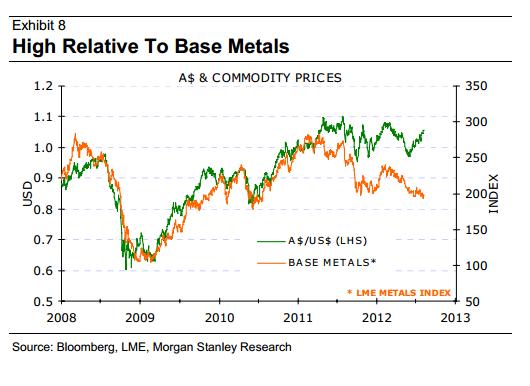But the strength of the dollar is still a cause for concern, even, it seems, for the RBA.
Following Tuesday’s decision to leave the official cash rate on hold at 3.5 per cent, it noted the exchange rate had “remained high, despite the observed decline in the terms of trade and the weaker global outlook”.
This is the first time the RBA has so implied the dollar is high, or somewhat stretched, relative to trade fundamentals, say local economists. And possibly a signal that if the dollar became really stretched (say $1.35 against its US counterpart, while the iron ore price languished at $100 a tonne) that RBA would go all Swiss National Bank on its own currency.
Neil Hume appears to have pulled these figures out of the ether but it does pose the interesting question about what is the right level to intervene in the dollar. To me, we’re already past it. Here’s the great divergence I’ve pointed to many times in the past few months and taken up yesterday by Gerard Minack:
To me that’s evidence enough. Waiting until the dollar gets to $135 and iron ore to $100 is forcing an economic adjustment you neither need nor want. Indeed, to allow that would culminate in a collapse. China is going to rebalance in next few years. Commodity prices are going to fall too. Very likely both will happen more swiflty than the happy analysts of Treasury of the RBA reckon on.
Why on earth would you hollow out your tradeable sector on the eve of such a shift?


